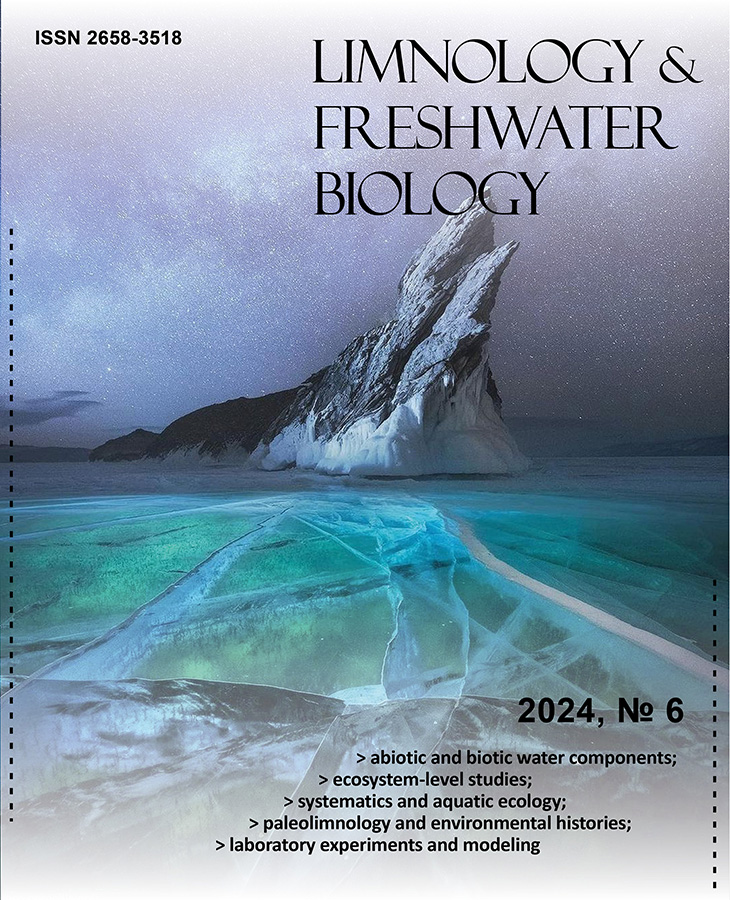Comrapative analysis of inverted sequences of noncoding region in the mitochondrial DNA of the Baikal sponges (Fam. Lubomirskiidae)
- Authors: Maikova O.O.1, Balakshin D.D.1,2, Belikov S.I.1
-
Affiliations:
- Limnological Institute, Siberian Branch of the Russian Academy of Sciences
- Irkutsk State University
- Issue: No 2 (2018)
- Pages: 98-102
- Section: Articles
- URL: https://journals.rcsi.science/2658-3518/article/view/284244
- DOI: https://doi.org/10.31951/2658-3518-2018-A-2-98
- ID: 284244
Cite item
Full Text
Abstract
In recent years, mitochondrial DNA (mtDNA) has been used to solve many phylogenetic problems at different taxonomic levels. Previously, the nucleotide sequences of the mitochondrial genomes of the Baikal endemic sponge species of the Lubomirskiidae family have been identified. Their phylogenetic links are still being actively studied, and their systematics is considered to be not definitive. In order to study the mechanisms of speciation and evolution of mtDNA, special attention is paid to the investigations of noncoding DNA. We have studied the characteristics of the organization of the intergenic mtDNA regions in the Baikal sponges on the example of the longest region between the tRNATyr and tRNAIle genes of the species L. baicalensis, S. papyracea, R. echinata, and B. intermedia profundalis. A comparative analysis of the sequences has shown the presence of secondary structures represented by individual hairpins and complex multilevel structures. Based on a comparative analysis of secondary structures, we have suggested their role as both regulative elements and potential mobile elements. We have determined the continuity of these structures among representatives of different genera of the Lubomirskiidae family. The highest similarity in their distribution and localization was found in phylogenetically related species of the Baikal sponges.
About the authors
O. O. Maikova
Limnological Institute, Siberian Branch of the Russian Academy of Sciences
Author for correspondence.
Email: maikova@lin.irk.ru
Russian Federation, Ulan-Batorskaya Str., 3, Irkutsk, 664033
D. D. Balakshin
Limnological Institute, Siberian Branch of the Russian Academy of Sciences; Irkutsk State University
Email: maikova@lin.irk.ru
Russian Federation, Ulan-Batorskaya Str., 3, Irkutsk, 664033; Sukhe-Batora Str., 5, 664011
S. I. Belikov
Limnological Institute, Siberian Branch of the Russian Academy of Sciences
Email: maikova@lin.irk.ru
ORCID iD: 0000-0001-7206-8299
Russian Federation, Ulan-Batorskaya Str., 3, Irkutsk, 664033
References
- Efremova S.M. 2001. Sponges (Porifera). In: Timoshkin O.A. (Ed.), Index of animal species of Lake Baikal fauna and its catchment area. Novosibirsk, pp. 179–192. (in Russian)
- Efremova S.M. 2004. Novel genus and novel species of the Lubomirskiidae Rezvoj, 1936 sponge family. In: Timoshkin O.A. (Ed.), Index of animal species of Lake Baikal fauna and its catchment area. Novosibirsk, pp. 1261–1278. (in Russian)
- Erpenbeck D., Voigt O., Wörheide G. et al. 2009. The mitochondrial genomes of sponges provide evidence for multiple invasions by Repetitive Hairpin-forming Elements (RHE). BMC Genomics 10: 1–14. doi: 10.1186/1471-2164-10-591
- Gazave E., Lapebie P., Renard E. et al. 2010. Molecular phylogeny restores the supra-generic subdivision of homoscleromorph sponges (Porifera, Homoscleromorpha). PLoS ONE 5: 12. e14290. doi: 10.1371/journal.pone.001429
- Hofacker I.L. 2003. Vienna RNA secondary structure server. Nucleotide Acids Research 31: 3429–3431. doi: 10.1093/nar/gkg599
- Itskovich V., Kaluzhnaya O., Veynberg Y. et al. 2017. Endemic Lake Baikal sponges from deep water. 2: Study of the taxonomy and distribution of deep-water sponges of Lake Baikal. Zootaxa 4236: 335–342. doi: 10.11646/zootaxa.4236.2.8
- Jukes T.H., Cantor C.R. 1969. Evolution of protein molecules. In: Munro H.N. (Ed.), Mammalian Protein Metabolism. New York, pp. 21–123.
- Kolesnikov A.A., Gerasimov E.S. 2012. Diversity of mitochondrial genome organization. Biochemistry 77: 1424–1435. doi: 10.1134/S0006297912130020
- Lavrov D.V. 2010. Rapid proliferation of repetitive palindromic elements in mtDNA of the endemic Baikalian sponge Lubomirskia baicalensis. Molecular Biology and Evolution 27: 757–760. doi: 10.1093/molbev/msp317
- Lavrov D.V., Maikova O.O., Pett W. et al. 2012. Small inverted repeats drive mitochondrial genome evolution in Lake Baikal sponges. Gene 505: 91–99. doi: 10.1016/j.gene.2012.05.039
- Lavrov D.V., Pett W. 2016. Animal mitochondrial DNA as we do not know it: mt-genome organization and evolution in nonbilaterian lineages. Genome Biology and Evolution 8: 2896–2913. doi: 10.1093/gbe/evw195
- Ling W., Xuming Z., Liuwang N. 2011. Organization and variation of mitochondrial DNA control region in pleurodiran turtles. ZOOLOGIA 28: 495–504. doi: 10.1590/S1984-46702011000400011
- Lukic-Bilela L., Brandt D., Pojskic N. et al. 2008. Mitochondrial genome of Suberites domuncula: Palindromes and inverted repeats are abundant in non-coding regions. Gene 412: 1–11. doi: 10.1016/j.gene.2008.01.001
- Maikova O.O., Stepnova G.N., Belikov S.I. 2012. Variations in noncoding sequences of the mitochondrial DNA in sponges from family Lubomirskiidae. Doklady Biochemistry and Biophysics 442: 46–48. doi: 10.1134/S1607672912010140
- Maikova O., Khanaev I., Belikov S. et al. 2015. Two hypotheses of the evolution of endemic sponges in Lake Baikal (Lubomirskiidae). Journal of Zoological Systematics and Evolutionary Research 53: 175–179. doi: 10.1111/.jzs.12086
- Paquin B., Laforest M.-J., Lang B.F. 2000. Double-hairpin elements in the mitochondrial DNA of Allomyces: Evidence for Mobility. Molecular Biology and Evolution 17: 1760–1768. doi: 10.1093/oxfordjournals.molbev.a026274
- Wang X., Lavrov D.V. 2008. Seventeen new complete mtDNA sequences reveal extensive mitochondrial genome evolution within the Demospongiae. PLoS ONE 3: 1–11. doi: 10.1371/journal.pone.0002723
- Zuker M. 2003. Mfold web server for nucleic acid folding and hybridization prediction. Nucleic Acids Research 31: 3406–3415. doi: 10.1093/nar/gkg595
Supplementary files










